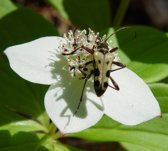Long-term time-lapse video provides near complete records of floral visitation
DOI:
https://doi.org/10.26786/1920-7603(2015)16Abstract
Accurate records of floral visitors are critical for understanding plant pollinator interactions. However, to date, sampling methods are constrained to short sampling periods and may be subject to observer interference. Thus, complete records without sampling bias are rare. We use a portable time-lapse digital video camera to capture near-complete records of visitors to flowers over their entire blooming period. We show the broad applicability of this method by filming a wide variety of flowers of different shapes and inflorescence types. We test the importance of long-term records by studying visitors to Cornus canadensis (bunchberry dogwood). Visitors to C. canadensis filmed simultaneously at four different sites show variation (both in rates and taxa) between inflorescences, between sites, throughout the day, and throughout the season. For C. canadensis our films also provide a record of pollen placement (an indirect measure of male fitness) and fruit set (female fitness). This technique provides near complete records of floral visitors, is likely to capture rare events, and allows simultaneous long-term filming. These results emphasize the importance of both long-term data collection and simultaneous recording at multiple sites for pollination studies.

Downloads
Published
How to Cite
Issue
Section
License
Copyright (c) 2015 Joan Edwards, Gordon P. Smith, Molly H.F. McEntee

This work is licensed under a Creative Commons Attribution 4.0 International License.











